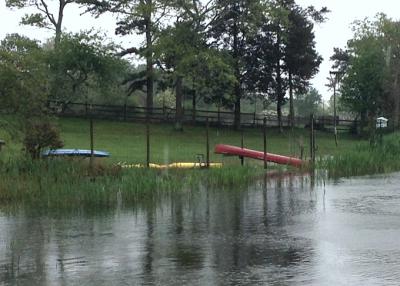Plea to Open Georgica Pond to Ocean

Conditions in Georgica Pond are ripe for yet another harmful algal bloom, the East Hampton Town Trustees were told on Monday, and they should consider an emergency opening of the pond to the Atlantic Ocean, which would mitigate the situation.
Sara Davison, executive director of the Friends of Georgica Pond Foundation, a group of homeowners working to improve the pond’s ecological health, told the trustees that because weather and water conditions prevented its traditional spring letting, the pond is a foot higher than it was at this time last year. “That has a very large horizontal spread effect,” she said, more than six feet.
The trustees were generally in favor of an emergency opening but differed as to how to go about it. They are presently negotiating with the State Department of Environmental Conservation for a permit to dredge the pond, a larger effort to increase water circulation.
“My biggest concern is it creating or having a negative impact on our dredging permits, which are bigger-picture, longer-term items,” said Jim Grimes. “That’s what’s fueling our trepidation.”
Complicating the issue, several pairs of federaly protected piping plovers have nested and laid eggs earlier than usual on the ocean beach bordering the pond.
Tyler Armstrong said that inaction was a greater danger, “because if it is so full and it breaks on its own in a storm, it’s going to cause more risks to the plovers, it’s more likely to cause an opening we can’t control. . . . I think it would help our dredging permit in the long run if we can show that we need to have this pond opened as much as possible because these kinds of situations arise. If we have the ability to control it manually, we are reducing the risk to endangered species and to adjacent properties.”
But Diane McNally, the board’s former clerk, did not support seeking permits from any agency, citing the trustees’ jurisdiction over the town’s common lands. The question of cooperating with the D.E.C., and even recognizing its authority, has been a source of friction among the trustees.
“What I am really reluctant to do,” Mr. Grimes said, “is create an atmosphere now that is so antagonistic with the agencies, by acting unilaterally on something, that we’re unable to move forward with anything.”
When working with other governing bodies, Ms. McNally said, the trustees’ unique status under the Dongan Patent of 1686, as an entity that predates them, must be maintained. That, she said, “means not recognizing that the D.E.C. can tell us when we can open the pond. If we need to open it for its health and safety, open it!” Instead of acknowledging the need for state or federal permission, “Go at it from another way,” she said.
“If we’re going to try to work for the overall health of the pond,” Bill Taylor, a deputy clerk, countered, “we all have to work together. It’s not just us, it’s not just one pond. These algae blooms, all this is going on all over the island, all over the world. We have to work together in a cohesive manner to get this done.”
“The pond is warming up,” Ms. Davison said. Salinity is extremely low and chlorophyll is very high, according to data transmitted by the telemetry buoy that was returned to the pond last week by Christopher Gobler and his researchers from Stony Brook University’s School of Marine and Atmospheric Sciences, who annually monitor the pond for both the trustees and the homeowners.
Dr. Gobler’s team is measuring bacteria in the pond this week, she said, and while measurements taken by the Surfrider Foundation on May 9 were low, “We’re very worried about what they are today, with the higher water levels and the proximity of septic systems to the pond.” Nitrogen and phosphorous leaching from septic systems also promote harmful algal blooms such as cyanobacteria, or blue-green algae, which has prompted the trustees to close the pond to the harvesting of crabs and other marine life for much of the last several summers.
Opening the pond to the ocean would lower the water level and temperature, and flush the bacteria that promote algal blooms.
The letting of Georgica Pond means a surge of water toward the ocean, an event that is impossible to control and can be dangerous. The presence of nesting plovers would typically preclude such an action.
But the Army Corps of Engineers, in consultation with the United States Fish and Wildlife Service, has granted the Southampton Town Trustees emergency opening permits for Mecox Bay and Sagaponack Pond, where there are nesting plovers, Ms. Davison pointed out. She asked that the East Hampton trustees take the same action.
“Of course, their nesting takes priority,” she said of the endangered shorebirds, “but our curiosity was piqued that the Army Corps and the Fish and Wildlife Service felt it was possible to have an emergency opening in those two other ponds in the presence of plovers.” She urged the board to contact the corps, the Fish and Wildlife Service, and the D.E.C. for permission to open the pond.
Ms. Davison asked that the trustees “look at the unique situation here, whether there’s any room to explore without jeopardizing the birds or the long-term success of the permit with the D.E.C. . . . It is a bad situation down there, and we would really be grateful if we could take a further look.”
“We’re going to look at it,” Mr. Taylor said.
